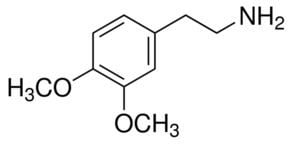Formula C10H13NO2 | Molar mass 181.23 g/mol | |
 | ||
3,4-Dimethoxyphenethylamine (DMPEA) is a chemical compound of the phenethylamine class. It is an analogue of the major human neurotransmitter dopamine where the 3- and 4-position hydroxy groups have been replaced with methoxy groups. It is also closely related to mescaline which is 3,4,5-trimethoxyphenethylamine.
Contents
Chemistry
One of the earliest syntheses of DMPEA (then referred to as "homoveratrylamine") was that of Pictet and Finkelstein, who made it in a multi-step sequence starting from vanillin. A similar sequence was subsequently reported by Buck and Perkin, as follows:
3,4-Dimethoxybenzaldehyde (veratraldehyde) → 3,4-Dimethoxycinnamic acid → 3,4-Dimethoxyphenylpropionic acid → 3,4-Dimethoxyphenylpropionamide → 3,4-DimethoxyphenethylamineA much shorter synthesis is given by Shulgin and Shulgin:
3,4-Dimethoxybenzaldehyde is reacted with nitromethane in the presence of ammonium acetate/acetic acid to give the corresponding β-nitrostyrene, which is then reduced with LiAlH4 to give 3,4-dimethoxyphenethylamine.
Pharmacology/Clinical
In the book PiHKAL, Shulgin describes DMPEA as producing no central effects in humans when tested even with very high doses, such as 1,000 mg orally or 10 mg via intravenous injection. However, DMPEA has been shown to have some activity as a monoamine oxidase inhibitor.
Occurrence
DMPEA occurs naturally along with mescaline in various species of cacti such as San Pedro and Peruvian Torch.
